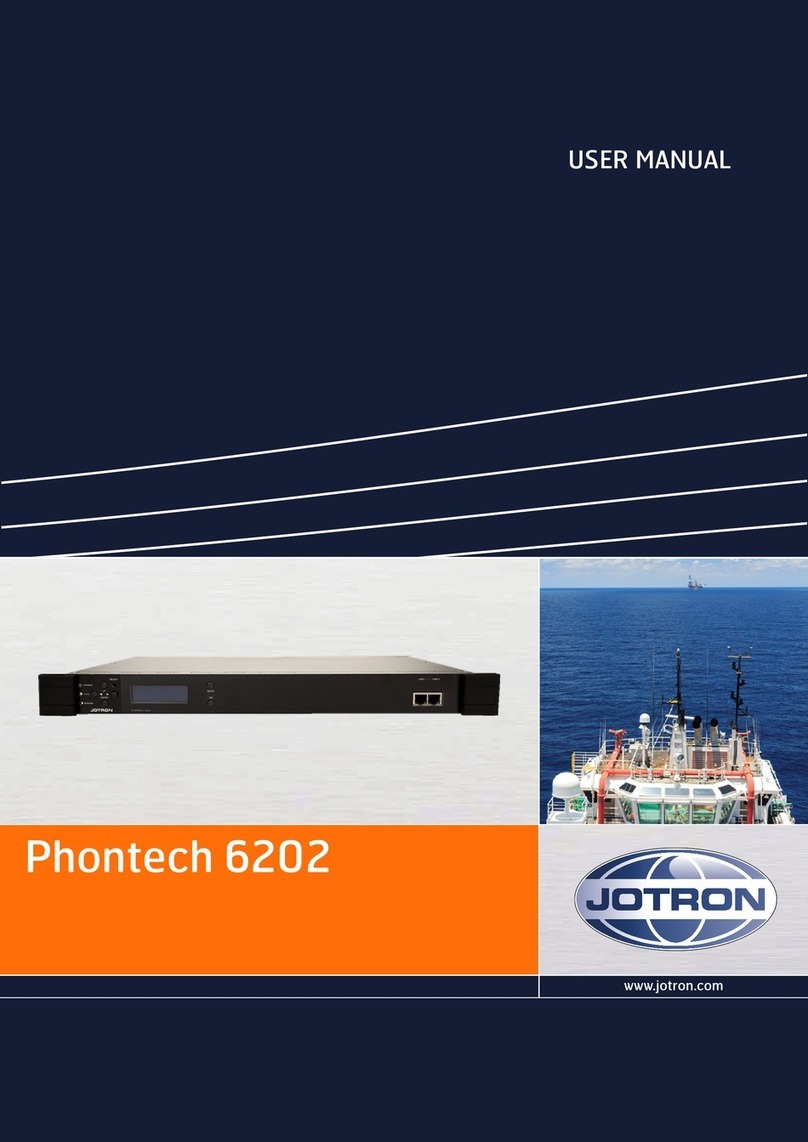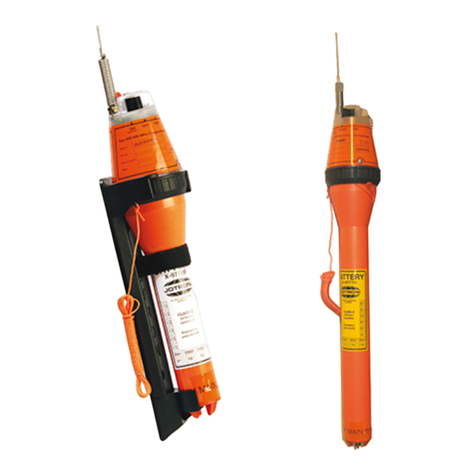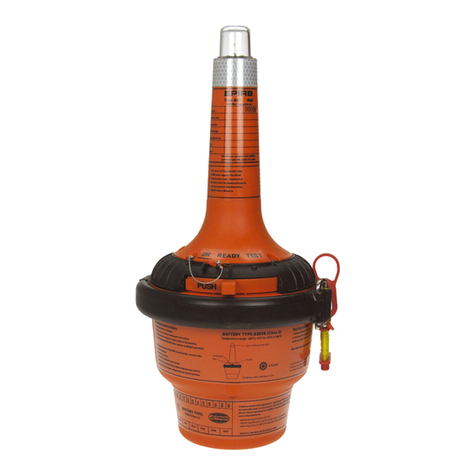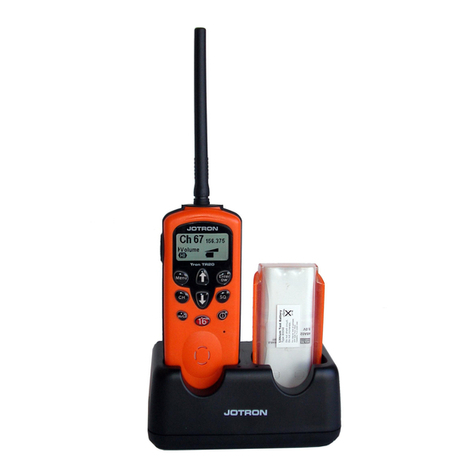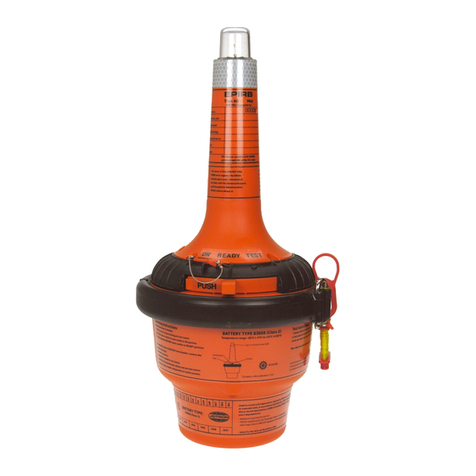jotron Tron 40S MkII User manual

www.jotron.com
USERS MANUAL
Tron 40S
Cospas Sarsat 406MHz EPIRB

EC Declaration of Conformity, available at www.jotron.com
AAbbbbrreevviiaattiioonnssaannddddeeffiinniittiioonnss
BAUD
Transmission rate unit of measurement for binary coded data (bit per second).
BIT
Short form of Binary Digit.The smallest element of data in a binary-coded value.
BITE
Built in test equipment.
BPS
Bits Per Second.
CHARACTER STRING
Continuous characters (other than spaces) in a message.
CHECKSUM
The value sent with a binary-coded message to be checked at the receiving end
to verify the integrity of the message.
COSPAS
COsmicheskaya Sistyema Poiska Avariynich Sudov (Space System for the Search
of Vessels in Distress)
CLOCK
A precisely spaced, stable train of pulses generated within an electronic system to
synchronize the timing of digital operations within the system.
DEFAULT
A condition that the navigator assumes automatically if no other condition is
initiated by the operator.

99744_UM_40S_G 3
EPIRB
Emergency Position Indicating Radio Beacon.
GLOBAL POSITIONING SYSTEM (GPS)
The NAVSTAR Global Positioning System, which consists of or- biting satellites,
a network of ground control stations, and user positioning and navigation
equipment.The system has 24 satellites plus 3 active spare satellites in six orbital
planes about 20,200 kilometers above the earth.
GPS
Global Position System
GPS SYSTEM TIME
Time corrected to Universal Time Coordinated (UTC) and used as the time
standard by the user segment of the GPS system.
IEC
International Electro-technical Commission.
IMO
International Maritime Organization
INTERFACE
Electronic circuits that permit the passage of data between different types of
devices; For example, the speed and heading interface circuit permits data from
a speed log and compass to pass to the navigator processor.
ITU
International Telecommunication Union.
LED
Light Emitting Diode.
LUT
Local User Terminal (Ground Station)
MCC
Mission Control Center

99744_UM_40S_G4
PROCESSOR
The processor circuit card in the console that controls system operations and
computes the positioning/navigation solutions.
RCC
Rescue Coordination Center
SARSAT
Search and Rescue Satellite-Aided Tracking System
SBM
Shore Based Maintenance - as required by SOLAS regulation IV/15.9.2
of SOLAS 1974 as amended with, in accordance with MSC/Circ.1039
guidelines for shore-based maintenance of Satellite EPIRBs within 5 years if:
Passenger ships (>12 passengers) and cargo ships (>300GT) engaged in interna-
tional voyages, shall perform Shore-Based Maintenance (SBM) as follows:
- Latest by the date of the EPIRB label with this text, or the battery
label, whichever is first.
- When this EPIRB becomes due for SBM in accordance with national
requirements.
SOFTWARE
Values programmed and preloaded into memory.The values represent
a permanent set of instructions for running the automatic functions
(computations) of the navigator.
VHF
Very High Frequency -A set of frequencies in the MHz region.
VSWR
Voltage standing wave ratio

99744_UM_40S_G 5
AMENDMENT
NO.
INCORP.
BY DATE PAGE(S) VERSION REASON FOR
CHANGE
ES 22.03.06 32 pages F Kontroll med
manualer.doc.
ES 14.09.06 6,7 and 22 G New text
A New manual
B New text
CNew text
DNew text
ENew text
1
2
3
4
5
6
7
8
9
10
11
12
13
14
15
16
17
18
19
20
21
22
23
Amendment Record

99744_UM_40S_G6
WARNING / IMPORTANT
Jotron Electronics a.s. is a prime manufacturer of safety equipment designed for
rescue of human lives and their property. For safety equipment to be effective in
line with the design parameters it is important that they are handled, stowed
and maintained in compliance with the manufacturers instructions. Jotron
Electronics a.s. can not be held responsible for any damage caused due to incorrect
use of the equipment or breach of laid down procedures or for failure of any
specific component or other parts of the equipment.
The chapter covering battery replacement (6.1.2) is added for information only.
Jotron Electronics a.s. does not take any responsibility for improper disassemb-
ling/assemblin of the beacon. We strongly recommend all service to be done by
authorized Jotron agents. In addition to normal service, Jotron agents have the
necessary equipment and education to test the operational functions of the beacon.
Non-original maintenance and/or service parts may destroy the equipment
function and performance.
The information in this book has been carefully checked and is believed to
be accurate. However, no responsibility is assumed for inaccuracies.
CAUTION!
This equipment contains CMOS integrated circuits. Observe handling
precautions to avoid static discharges which may damage these devices.
JOTRON electronics a.s reserves the right to make changes without
further notice to any products or modules described herein to improve
reliability, function or design. JOTRON electronic a.s does not assume any
liability arising out of the application or use of the described product.
TO PERMANENTLY DISABLE EPIRB
The battery module must be removed and treated
according to chapter 6.1.2 paragraph 1, 2, 3 and 4,
chapter 6.1.3, 6.1.4, 6.1.5 and 6.1.6 in this manual.
IMPORTANT

99744_UM_40S_G 7
TABLE OF CONTENTS
1 GENERAL DESCRIPTION . . . . . . . . . . . . . . . . . . . . . . . . . . . . . . . . . 12
1.1 TRON 40S . . . . . . . . . . . . . . . . . . . . . . . . . . . . . . . . . . . . . . . . . . . . . . . . . . . . . . 12
1.2 SYSTEM DESCRIPTION . . . . . . . . . . . . . . . . . . . . . . . . . . . . . . . . . . . . . . . . . . 13
1.2.1 Signal detection . . . . . . . . . . . . . . . . . . . . . . . . . . . . . . . . . . . . . . . . .13
1.2.2 Distress location determination . . . . . . . . . . . . . . . . . . . . . . . . . . . . .14
1.2.3 EPIRB registration . . . . . . . . . . . . . . . . . . . . . . . . . . . . . . . . . . . . . . . 14
2 TECHNICAL SPECIFICATION . . . . . . . . . . . . . . . . . . . . . . . . . . . . .15
3 FUNCTIONAL DESCRIPTION . . . . . . . . . . . . . . . . . . . . . . . . . . . . . .16
3.1 GENERAL ............................................................16
3.1.1 EPIRB module with antenna. . . . . . . . . . . . . . . . . . . . . . . . . . . . . . . . 16
3.1.2 battery module. . . . . . . . . . . . . . . . . . . . . . . . . . . . . . . . . . . . . . . . . . .17
3.1.3 Equator ring with gasket . . . . . . . . . . . . . . . . . . . . . . . . . . . . . . . . . . .17
4 INSTALLATION . . . . . . . . . . . . . . . . . . . . . . . . . . . . . . . . . . . . . . . . . . . .18
4.1 FLOAT FREE BRACKET FB5/FB4 . . . . . . . . . . . . . . . . . . . . . . . . . . . . . . . . . .18
4.2 FLOAT FREE BRACKET FBH4 . . . . . . . . . . . . . . . . . . . . . . . . . . . . . . . . . . . .18
4.3 MANUAL BRACKET MB5 AND MB4 . . . . . . . . . . . . . . . . . . . . . . . . . . . . . . .18
4.4 MOUNTING THE FB5/MB5/FB4/FBH4/MB4 BRACKETS . . . . . . . . . . . . . .18
5 OPERATING INSTRUCTIONS . . . . . . . . . . . . . . . . . . . . . . . . . . . . . .19
5.1 MANUAL OPERATION . . . . . . . . . . . . . . . . . . . . . . . . . . . . . . . . . . . . . . . . . . . 19
5.2 AUTOMATIC OPERATION . . . . . . . . . . . . . . . . . . . . . . . . . . . . . . . . . . . . . . . . 20
5.3 MANUAL TEST OF THE EPIRB . . . . . . . . . . . . . . . . . . . . . . . . . . . . . . . . . . . .20
6 MAINTENANCE AND TROUBLESHOOTING . . . . . . . . . . . . . . .21
6.1 EPIRB MODULE / BATTERY MODULE . . . . . . . . . . . . . . . . . . . . . . . . . . . . .21
6.1.1 Change of battery . . . . . . . . . . . . . . . . . . . . . . . . . . . . . . . . . . . . . . . .21
6.1.2 Replacing the battery module . . . . . . . . . . . . . . . . . . . . . . . . . . . . . . . . . . .21
6.1.3 Battery disposal . . . . . . . . . . . . . . . . . . . . . . . . . . . . . . . . . . . . . . . . .22
6.1.4 Incineraton . . . . . . . . . . . . . . . . . . . . . . . . . . . . . . . . . . . . . . . . . . . . .22
6.1.5 Land Filling . . . . . . . . . . . . . . . . . . . . . . . . . . . . . . . . . . . . . . . . . . . .22
6.1.6 Recycling . . . . . . . . . . . . . . . . . . . . . . . . . . . . . . . . . . . . . . . . . . . . . .22
6.2 HYDROSTATIC RELEASE REPLACEMENT . . . . . . . . . . . . . . . . . . . . . . . . . .23
6.2.1 Replacing the release mechanism in FB4/FBH4 bracket . . . . . . . . . .23
6.2.2 Replacing the release mechanism in FB5 bracket . . . . . . . . . . . . . . .23
6.3 TRON 40S SELF TEST . . . . . . . . . . . . . . . . . . . . . . . . . . . . . . . . . . . . . . . . . . . .24
6.4 EPIRB MODULE ERROR MESSAGES . . . . . . . . . . . . . . . . . . . . . . . . . . . . . .25
7 FIGURES . . . . . . . . . . . . . . . . . . . . . . . . . . . . . . . . . . . . . . . . . . . . . . . . . . 26
8 SERVICE AGENTS . . . . . . . . . . . . . . . . . . . . . . . . . . . . . . . . . . . . . . . . .34

99744_UM_40S_G8
BATTERY SAFETY DATA SHEET
(Form: EEC directive 91/155)
(2) SAFETY ADVICE
S2 Keep out of reach from children.
S8 Keep container dry.
S26 In case of contact with eyes, rinse immediately with
plenty of water and seek medical advice.
S43 In case of fire, use D type extinguishers. Never use water.
S45 In case of accident or if you feel unwell, seek medical
advice immedately (show the label where possible).
(3) FIRST AID MEASURES
In case of contact of cell contents with eyes, flush immediately
with water for 15 min.With skin, wash with plenty of water and
take off contaminated clothes. If inhalation, remove from exposure,
give oxygen, seek medical advice.
(4) FIRE-FIGHTING MEASURES
Extinguishing media
Suitable: Type D fire extinguishers
Not to be used: Water - CO2- Halon, dry chemical or foam
extingiushers
Special exposure hazards
Generation of chlorine, sulfur dioxide, disulfur dichloride during
thermal decomposition.
Special protective equipment
Use protective working boots, rubber apron and safety glasses
with side shields.

99744_UM_40S_G 9
INSTRUCTIONS FOR KEEPING THE RADIO LOG AND
THE RADIO OPERATORS OBLIGATION ACCORDING
TO NATIONAL AND INTERNATIONAL REGULATION.
1. The radio log shall be kept in accordance with requirements in the Radio
Regulations, SOLAS Convention, national regulations regarding radio installations
and the STCW Convention (STCW 95 including the STCW Code) including
relevant regulation regarding watchkeeping on board passenger- and cargo ships.
2. Unauthorized transmissions and incidents of harmful interference should,
if possible, be identified, recorded in the radio log and brought to the attention
of the Administration in compliance with the Radio Regulations, together with
an appropriate extract from the radio log. (STCW Code B-VIII/2 No.32)
TEST OF RADIO EQUIPMENT AND RESERVE SOURCE OF ENERGY
Weekly:
GMDSS handheld VHF transceivers to be tested without using the mandatory
required emergency batteries.
Monthly:
Float-free and manual EPIRBs to be checked using the means provided for testing on the
equipment. Check data for periodical maintenance requirement for float-free EPIRB.
Search and rescue radar transponders (SART) to be checked against 9 GHz radar.
False alerts transmitted by EPIRB
False alerts are a serious problem for the rescue service. Nearly 90% of EPIRB
initiated distress alerts turn out to be false alarms.

10 99744_UM_40S_G
If for any reason, your EPIRB should cause a false alarm, it is most important that you
contact the nearest search and rescue authority and tell them it was a false alarm. They
can then stand down any rescue service (coast radio station or appropriate CES or
RCC). Use any means at your disposal to make contact. Switch off the distress alarm
by de-activating your EPIRB, as soon as possible.
If your beacon is activated in a non-distress situation or a distress situation which
has been resolved and you no longer require assistance, contact the nearest search
and rescue authorities via the most expeditious means available with the following
information:
Beacon ID number (15 character UIN):
Position (At time of activation):
Date of Activation:
Time of Activation (Time zone):
Duration of Activation:
Beacon marke and model:
Vessel Name/lD:
Circumstances/cause (if known):
The United States search and rescue authority is the U.S. Coast Guard. The
primary points of contact are:
Pacific Ocean Area
USCG Pacific Area Command Centre
Tel: (510)-437-3701
Atlantic Ocean / Gulf of Mexico Area
USCG Atlantic Area Command Centre
Tel: (757)~398-6231
From Any Location
USCG Headquarters Command Centre
Tel: (800)-323-7233

1199744_UM_40S_G
DATE N/T/B SIGN INSP
N=NEW EPIRB INSTALLED,T=TEST, B=NEW BATTERY
TEST AND MAINTENANCE RECORD

99744_UM_40S_G12
1. GENERAL DESCRIPTION
The Tron 40S is an emergency equipment consisting of:
• Tron 40S COSPAS/SARSAT emergency EPIRB
• One of the following brackets:
FB4 - Automatic float free bracket.
FBH4 - Automatic float free bracket v/heating.
MB4 - Manual bracket.
MB5 - Manual bracket.
FB5 - Automatic float free bracket.
The JOTRON Tron 40S EPIRB is developed to meet the regulations and rules for
use on vessels and life rafts in the maritime service.Tron 40S meets the following
specifications for 406 MHz EPIRBs for use in search and rescue operations at sea:
ETS 300 066
MPT 1259
C/S T.001
IMO A662
IMO A695 (17){1}
IMO A810 (19)
DIR 96/98 EEC
1.1 TRON 40S
The Tron 40S is buoyant, and is designed to automatically release and activate in case
of an emergency where the EPIRB and its bracket is submerged into the sea.The Tron
40S can also be operated as a manual EPIRB, by manually releasing it from its bracket
and then activate it.
Five different brackets are currently available for the Tron 40S. MB4 and MB5 is the
manual bracket and FB4 and FBH4 is the automatic bracket. FB5 is automatic
bracket with cover.The manual bracket comes without the hydrostatic release
mechanism and is used to store the beacon inside the wheelhouse or other
protected places.The automatic bracket is mounted in a free space outside where
the beacon can be released automatically.
The purpose of the Tron 40S is to give a primary alarm to the search and rescue
authorities.The EPIRB gives an immediate alarm when activated, transmitting the ID
of the ship in distress. Care must be taken not to activate the EPIRB unless in an
emergency situation, in such cases the user will be held responsible. For periodic
testing a test function is implemented. During the test cycle the EPIRB does a selftest
on the transmitters and on the battery status. No emergency signal is transmitted
during the selftest.
The battery of the EPIRB will last for at least 48 hours from activation of the EPIRB.

99744_UM_40S_G 13
1.2 SYSTEM DESCRIPTION
The COSPAS/SARSAT system was introduced in 1982 as a world wide search and
rescue system with the help of satellites covering the earth’s surface. Since the
introduction of the system more than 18865 persons have been rescued by the
COSPAS/ SARSAT system (2004). Currently the system consists of 5 functional
satellites in a polar orbit constellation, these satellites cover the entire earth’s surface
and receive the emergency signal from the 406 MHz transmitter within the Tron 40S,
more polar orbiting satellites will be available in the future, giving a faster location
and rescue time.
In addition several geostationary satellites are equipped with a 406 MHz tranponder,
these satellites are not able to locate the Tron 40S but will give an early warning to
the rescue forces, minimising the time from an emergency occurs till the rescue
forces are at the site.
Each emergency EPIRB in the system is programmed with its own unique code,
therefore it is vital that the ships data that is given to the dealer you obtained your
Tron 40S, is correct. It is also important that your EPIRB is registered in the database
for each country.This database is normally located in the same country that the ship
is registered.
1.2.1 SIGNAL DETECTION [FIG. 1]
When the Tron 40S is activated (manually or automatically) it transmits
on the frequencies 121.5 MHz and 406.025 MHz.An analogue signal is emitted on 121.5
MHz and a digital signal is transmitted on 406.025 MHz. After the Tron 40S is activated,
the next passing satellite will detect the transmitted signal and relay it to an antenna at a
ground station, called a LUT.
For the 121.5 MHz signal the satellite must be within line of sight of both the Tron
40S and a ground station.The ground station or LUT has a 2500 km satellite recep-
tion radius centred at the LUT. In areas without LUT coverage (mostly less popu-
lated areas in the southern hemisphere), signals from the 121.5 MHz transmitter will
not be detected by the satellites, only by passing aircraft’s.This is not the case with
the 406 MHz transmitter, because the satellites have a memory unit which stores the
signals for relay to the next available LUT giving it a truly global coverage.
Once the signal is received by the LUT, it is processed for location and sent to a
Mission Control Centre (MCC).The MCC sorts the alert data according to
geographic search and rescue regions and distributes the information to the appro-
priate Rescue Co-ordination Centre (RCC), or if outside the national search and
rescue area, to the appropriate MCC that covers the area where the distress signal
was detected.The RCC in turn takes the necessary action to initiate search and
rescue activities.
The International Cospas-Sarsat System will cease satellite processing of 121.5/243
MHz beacons from 1 February 2009. From that date only 406 MHz beacons will
be detected by the Cospas-Sarsat satellite system.This affects all maritime beacons
(EPIRBs), all aviation beacons (ELTs) and all personal beacons (PLBs).

99744_UM_40S_G
1.2.2 DISTRESS LOCATION DETERMINATION [FIG. 1]
The location of the distress signal is determined by taking measurements of the
doppler shift of the EPIRB frequency when the satellite first approach and then pass
the EPIRB.
The actual frequency is heard at the time of closest approach (TCA). Knowing the
position of the satellite and using the received doppler signal information, it is
possible to determine the location of the Tron 40S from the satellite at the TCA.At
the LUT, actually two positions are calculated. One is the actual position (A) and the
other is the mirror image (B) position.A second satellite pass confirms the correct
location (A).With the 406 system the real solution can be determined on the first
pass with a reliability of nearly 90% and down to an accuracy of less than 5 km (3.1
miles).
1.2.3 EPIRB REGISTRATION
Normally the MCC will contact the vessel or the contact person registered in a ship-
ping register and/or an EPIRB register (Ships owner, family member etc.) before aler-
ting the RCC.This is to determine if the alarm from the EPIRB for some reason is a
false alarm, and an expensive rescue operation can be avoided. Because of this it is
important that the ships data is correct in the shipping register or in the EPIRB data-
base.
Tron 40S purchased in some countries will have a registration form attached to it, it is
important that this registration form is completed by the owner and returned to the
place the EPIRB was purchased or to the address specified on the registration form.
Other countries use the already available shipping register to obtain the necessary
information for a vessel in distress, in these countries the ship is already registered
and no registration form is necessary, however it is vital that the coding of the Tron
40S is kept up to date with datas on the ship (nationality, call sign, etc.), to minimise
the time from an alarm to the start of the search and rescue operation.
Reprogramming theTron 40S can be done at authorised JOTRON agents in more
than 180 different places throughout the world.
If you are a resident of the United States, you must register this beacon with the
National Oceanic and Atmospheric Administration (NOAA) using the registration
card included with the unit. Fill out the form and send it to:
SARSAT Beacon Registry, NOAA-SARSAT, E/SP3, FB4, Room 3320, 5200 Auth Road,
Suitland, MD 20746-4304
Vessel owners shall advise NOAA in writing upon change of vessel or EPIRB
ownership.Transfer of EPIRB to another vessel, or any other change in registration
information, NOAA will provide registrants with proof of registration and change of
registration postcards.
14

99744_UM_40S_G 15
2. TECHNICAL SPECIFICATIONS
2.1 GENERAL
2.2 COSPAS/SARSAT TRANSMITTER
Item: Description:
Frequency: 406.025 MHz -
+2 ppm
Output power: 5W -
+2 dB
Protocols: Tron 40S: Maritime, Serialised, Radio Callsign
Modulation: Phase modulation 1.1 -
+0.1 rad
Data encoding: Bi Phase L
Stability: Short term <
-10
-9
Medium term <
-10
-9
Residual noise <
- 3x10-9
Bitrate: 400 b/s
Antenna: Built in, omnidirectonal.
Item: Description:
Battery: Lithium, 5 years service life.
Housing: Polycarbonate w/ 10% glassfibre
Dimensions: Height: 379 mm
Max diameter: 180 mm
Weight app:. 2.0 kg
Materials: Polycarbonate.
Compass safe distance: 1.5 m
Temperature range: -20oC to + 55oC
Operating life: Minimum 48 hours at -20oC
2.3 HOMING TRANSMITTER
2.4 BRACKET [FIG. 8]
Frequency: 121.500 MHz
Output power: Up to 100 mW,
depending on model.
Modulation: A9,AM sweep tone between
300Hz and 1600Hz.
Sweep range 700 Hz.
Sweep rate 2.5 Hz.
Stability: 10 ppm over temperature range.
Antenna: Built in, omnidirectional.
Materials: Luran S/ ABS
Dimensions: See (FIG. 8)
Depth w/Beacon intalled: 200 mm
Weight: app 1.6 kg
Release mechanism: Hydrostatic release
unit Hammar H20
with Jotron special bolt

99744_UM_40S_G16
3 FUNCTIONAL DESCRIPTION
3.1 GENERAL
The Tron 40S consists of upper and lower house mounted together with an equator
ring with gasket and locking pin.
Tron 40S may be split into the following main parts:
1. EPIRB module with antenna
2. Battery module
3. Equator ring with gasket.
3.1.1 EPIRB MODULE WITH ANTENNA
The EPIRB module consists of two printed circuit boards, which are mounted in the
upper housing:
1.The main board w/, Xenon flash and an indicator LED
2.Antenna board. (121.5 / 406 MHz)
For automatic activation of the EPIRB module, put the Tron 40S in the upright
position into the water, and the transmission starts when the seawater completes
the circuit between the two external electrodes (sea water contacts).
When the Tron 40S is mounted in the automatic release bracket mechanism, there
is a safety switch in the EPIRB module, a reed contact activated by a magnet at
the bracket, which disables the seawater contacts.
If the 40S mounted in the automatic release bracket is submerged in water, the
hydrostatic release mechanism will release the Tron 40S at a depth of 2-4 meters.
The transmission will start when the circuit between the seawater contacts is closed
and the Tron 40S is out of the bracket.
The EPIRB module may be manually activated with the main switch, and is then
independent of seawater contacts.The EPIRB module will also operate while placed
in the bracket when manually activated.
The Tron 40S may easily be released from the mounting bracket manually.
The main switch is also located on the main board.
The housing is made of polycarbonate.

99744_UM_40S_G 17
3.1.2 BATTERY MODULE
The Battery module is feeding the EPIRB module with 14.4VDC power to
keep the EPIRB transmitters active for 48 hours when activated, and for test
sequences.
The battery module consists of four SAFT LSH20 Lithium-Thionyl chloride
(Li-SOCL2) batteries connected in series and is attached inside the lower
house.
The housing is made of polycarbonate. In the lower part of the housing there
is one reed contact which is activated by a magnet in the release mechanism.
This is the safety switch which prevent the seawater contacts to activate the
beacon while placed in the release mechanism.
There is a brass weight which gives stability while floating.
The seawater contacts is also mounted in the battery module, and is connected
to the electronic unit via the battery connector.
The batteries is mounted in with a plastic battery holder.
3.1.3 EQUATOR RING WITH GASKET
The two parts of the housing are held together by the equator ring, and is
locked with a U-shaped bolt of stainless steel and a split pin. Between the two
halves of the housing there is a gasket made of neoprene.

18 99744_UM_40S_G
4. INNSTALLATION
BRACKETS
Five different brackets are currently available for the Tron 40S. MB5 and MB4 are
the manual brackets. FB5, FB4 and FBH4 are the automatic brackets. The manual
brackets comes without the hydrostatic release mechanism and is used to store the
beacon inside the wheelhouse or other protected places. The automatic
brackets are mounted in a free space outside where the beacon can be released
automatically. MB5 and FB5 are delivered with protective cover.
4.1 FLOAT FREE BRACKET FB5 AND FB4
WARNING:
DO NOT INSTALL THE EPIRB NEAR STRONG
MAGNETIC FIELDS THAT COULD ACTIVATE THE BEACON.
When the Tron 40S is mounted in the float-free bracket, FB5 or FB4, it will operate as
an automatic float free unit. Since the release of the EPIRB will be
automatic it is important to mount the bracket in a place where there are no obsta-
cles that can endanger the automatic release of the EPIRB.The location where the
bracket is mounted should be as high as possible on the vessel, and well protected
from environmental conditions such as direct sea-spray, chemicals, oil, exhaust and
vibrations.The location must also be easily accessible for testing and maintenance.
4.2 FLOAT FREE BRACKET FBH4
See fig. 8 for installation.The float free bracket FBH4 must be connected to the
fixed installation (230V AC, 10A) through the thermostat connection box
according to the connection diagram below.
4.3 MANUAL BRACKET MB5 AND MB4
When the Tron 40S is mounted in the MB5 or MB4 bracket, it will operate as a
manual unit.This bracket is similar to the FB5 and FB4 bracket but does not have
the hydrostatic release mechanism.This bracket is typically used to store the EPIRB
inside the wheel house or other protected areas of the ship.When the Tron 40S is
mounted in the MB5 or MB4 bracket, it must be manually removed before any
operation can take place, therefore the bracket should be mounted in an easily
accessible place where it can be reached in a hurry in case of an emergency.
4.4 MOUNTING THE FB5/MB5/FB4/FBH4/MB4 BRACKETS [FIG. 8]
The bracket is mounted with 4x6mm bolts according to the drawing. Use the bolts
supplied with the bracket.The bracket could be mounted in either an upright or
horizontal position, whichever is the best regarding maintenance and operation.
CONNECTION DIAGRAM
HEATING ELEMENT
THERMOSTAT
230V AC, 10A

1999744_UM_40S_G
5. OPERATING INSTRUCTIONS
The Tron 40S is designed to be operated either manually or automatically.The
EPIRB is always armed, that is the EPIRB will automatically start to transmit when
the EPIRB is out of the bracket and deployed into water. In the lower part of the
EPIRB there is an automatic safety switch.This switch prevents the seawater-
contacts from operating the EPIRB (caused by ice, sea-spray etc.) as long as the
EPIRB is placed in its bracket.
See 6.4 Error codes.
5.1 MANUAL OPERATION [FIG. 2]
Warning
USE ONLY DURING SITUATIONS
OF GRAVE AND IMMINENT DANGER
For operation of the beacon in the bracket please follow instructions 1 to 6.
To manually remove the beacon from the bracket, pull out the locking pin on the
clamp and open the retaining rod that holds the beacon.
Tie the beacon lanyard to you or to the survival craft and then follow instruc-
tions 1 to 6, or put beacon in the water to activate it.
It is not recommended to operate the beacon inside a liferaft or under a cover
or canopy. Do NOT tie the lanyard to the ship in distress, as this will prevent the
unit to functioning if the ship sinks.
1. Break the seal and pull the locking pin holding the main activator switch.
2. Push slider to move switch to ON/EMERGENCY position.
3. The switch is spring loaded and will automatically go to the
ON/EMERGENCY position.
4. The LED indicator, located at the top of the EPIRB, will start flashing
indicating that the EPIRB is operating. In addition the strobe light will start to
operate.The LED indicator will turn off after a few seconds.
5. If possible keep the EPIRB in an open area, away from any metal objects (ship
construction etc.) that may limit the satellite coverage.
6. Transmission can be stopped by turning the switch to READY position.

99744_UM_40S_G20
5.2 AUTOMATIC OPERATION (FB4/FBH4/FB5) [FIG. 3]
1. The Tron 40S will automatically release from the bracket, float to the surface and
start to transmit, when the EPIRB in its bracket is deployed into water at a depth
of app. 2-4 meters (6 - 13 feet).
2. Alternatively the EPIRB can be manually released from the bracket and put into
the water.
3. Transmission will continue until the EPIRB is lifted out of the water, and dried off.
The transmission can also be stopped by placing the EPIRB in the bracket.
5.3 MANUAL TEST OF THE EPIRB [FIG. 4]
To perform the self-test, the EPIRB has to be removed from the bracket.
FB4 bracket: Remove EPIRB from the bracket by pulling out the locking pin on
the clamp and open the retaining rod that holds the beacon.
FB5 bracket: Release FB5 to top cover by removing the locking split pin and
special washer.
WARNING! The EPIRB can drop out of the FB5 bracket when
releasing top cover.
1. Press the spring-loaded switch on top of the EPIRB to the TEST position.
Keep hands and other objects away from the upper part of the EPIRB (away
from the antenna).
2. A successful test will consist of a series of blinks on the LED test-indicator,
followed by a continuous light and a strobe flash after app. 15 seconds.
3. If the EPIRB fail to end up with a continuous light, this indicates a fault in the
EPIRB. See 6.4 EPIRB module error message.
4. Release the switch and put the EPIRB back into the bracket.What the self test
actually does is first to wait app. 15 seconds to allow the reference oscillator
inside the EPIRB to warm up.Then a short burst is transmitted by the 121,5 MHz
transmitter, while the output level of the transmitter is checked. Finally, a test
signal is transmitted by the 406 transmitter. During this test signal the battery
voltage, output power and frequency is checked.
While testing the 406 MHz transmitter a test message is transmitted, this test
message is coded with a special synchronisation code and will not be detected by
the COSPAS/SARSAT satellites.The purpose of this test message is to control the
actual coding of the EPIRB.This can be done with the JOTRON test unit Tron
DEC/UniDEC or an other EPIRB checker.
Other manuals for Tron 40S MkII
1
Table of contents
Other jotron Marine Equipment manuals
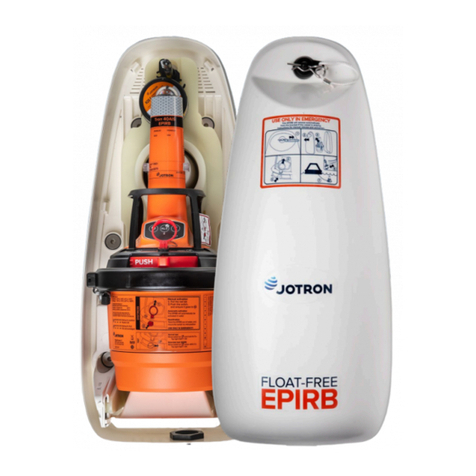
jotron
jotron Tron 40AIS User manual

jotron
jotron Tron 40AIS User manual

jotron
jotron Tron 60S User manual
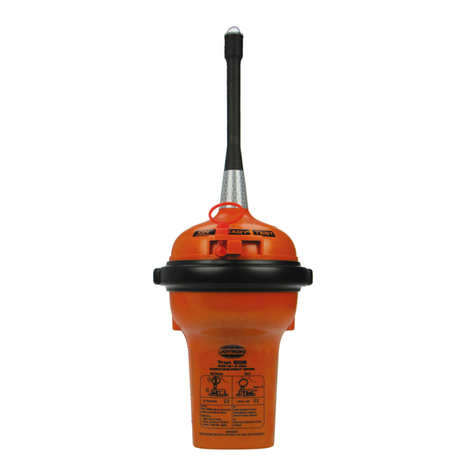
jotron
jotron Tron 60S User manual
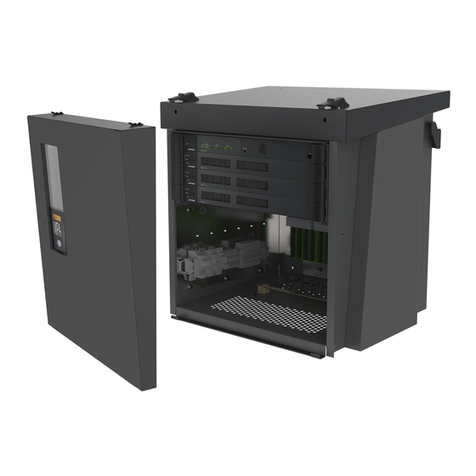
jotron
jotron MPA 1600 Operating manual
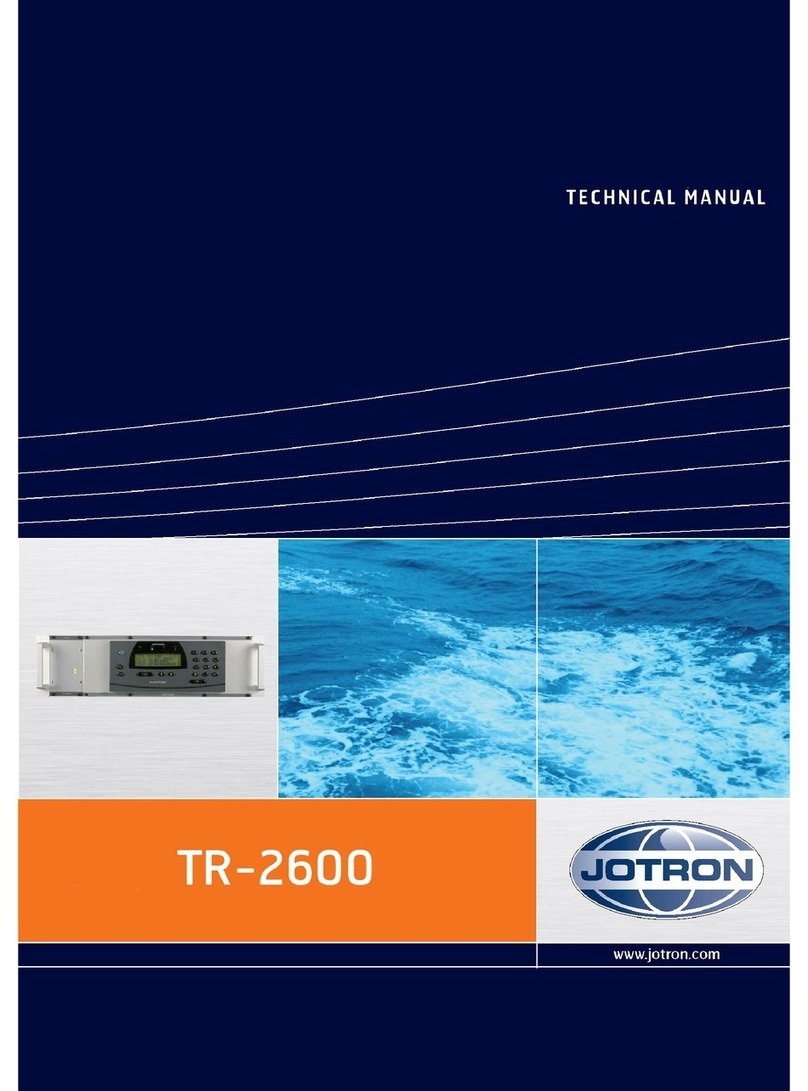
jotron
jotron TR-2600 User manual
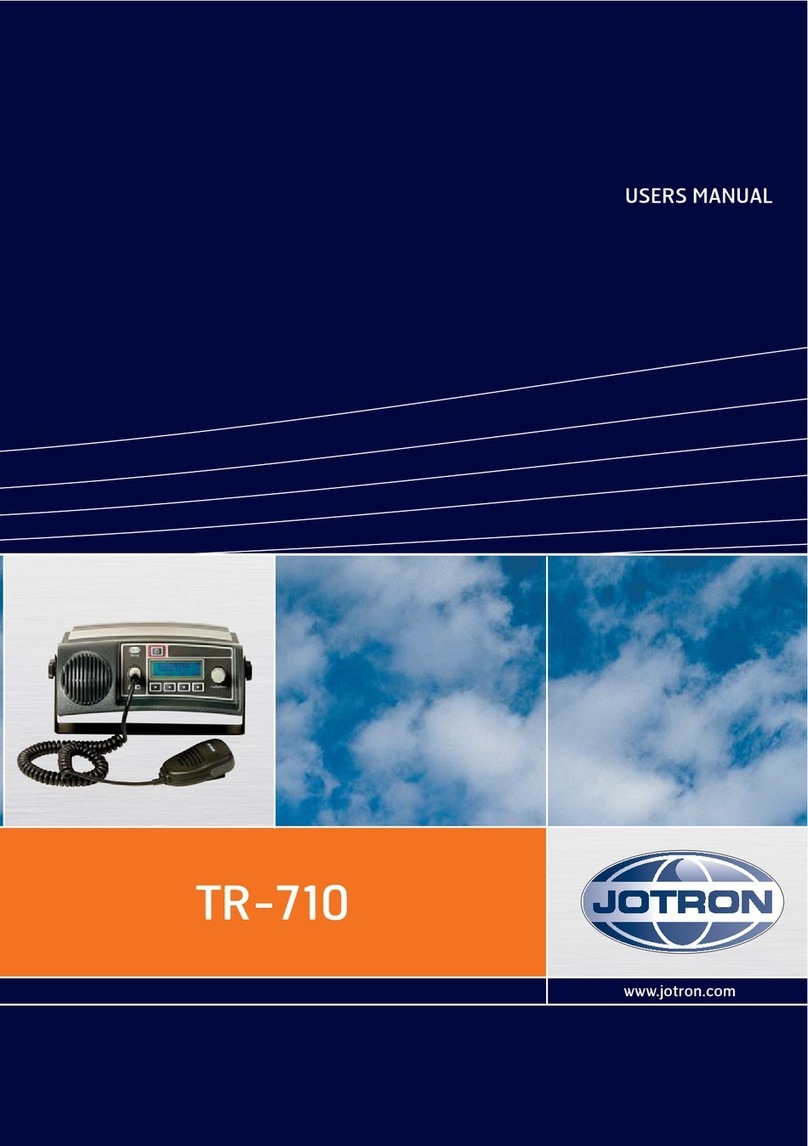
jotron
jotron TR-710 User manual
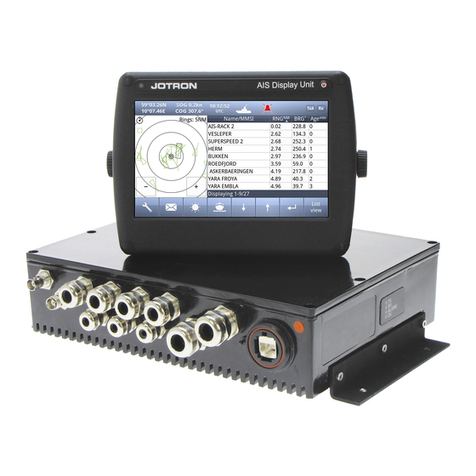
jotron
jotron Tron AIS TR-8000 User manual
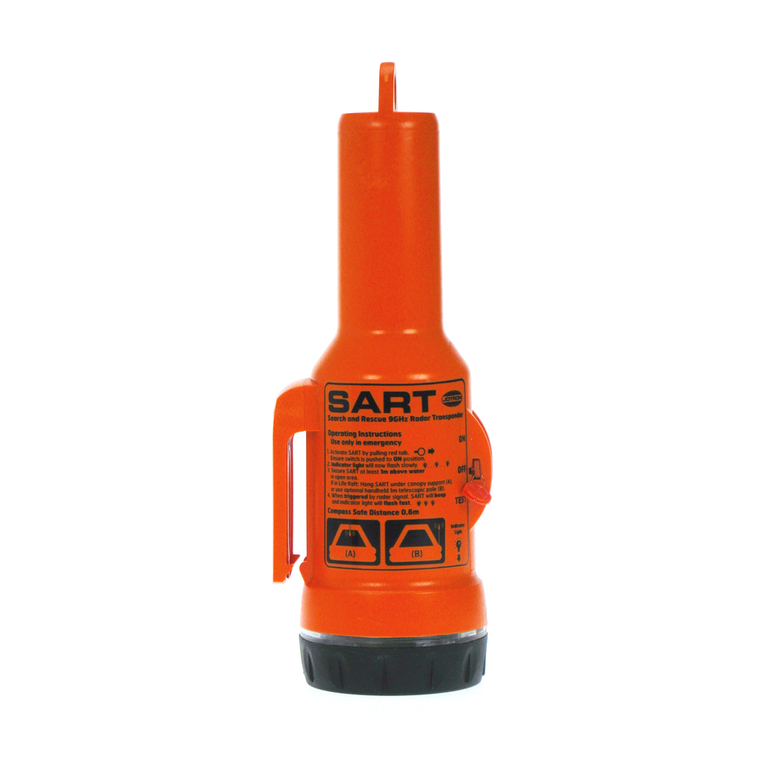
jotron
jotron Tron SART20 User manual

jotron
jotron TR-2600 Specification sheet

